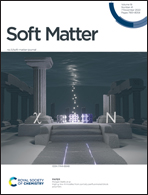A 3D printed hydrostatic skeleton for an earthworm-inspired soft burrowing robot
Abstract
Moving through soil is challenging for robots, particularly for soft robots. Herein, we propose a support structure, based on the hydrostatic skeleton of earthworms, to overcome this problem. To create extremely flexible, thin-walled, worm-sized deformed segments, a specialized 3D printer for low-hardness rubber was utilized. To obtain large radial deformation, we investigated the properties of the soft materials for 3D printing and the geometry of the segments. Notably, segments are deformed with multiply-wound shape memory alloy wires. We constructed an earthworm robot by connecting shape memory alloy-driven segments in series and experimentally demonstrated that this robot could propel in the soil. The proposed robot is unique in that it has a small diameter of 10 mm and exhibits a peristaltic motion in soil.

- This article is part of the themed collection: Soft Robotics


 Please wait while we load your content...
Please wait while we load your content...